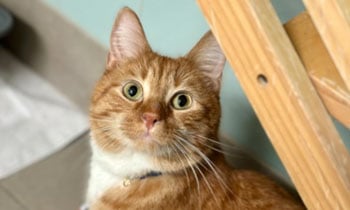The Lost Whiskey Project
Mark Turner dreamed of a place where friends could unplug and drink bourbon by the fire. Then he built it.
Like so many, Mark Turner found his business temporarily disrupted by Covid-19. When the pandemic arrived in 2020, the owner and founder of the alternatively hip design-build firm GreenSpur saw his company’s billable work grind to a halt. He poured himself a finger of whiskey and decided to use the slowdown to focus on a personal project: a “Covid cottage.”
“We had a lot of jobs that got shut down because of Covid, and we had a full [construction] crew, so we wanted to find work for them,” says Turner, whose 10-person company is based in Falls Church.
The endeavor—which he dubbed the Lost Whiskey Project—turned out to be something more than a cottage. Nestled on a 50-acre hilltop site in Delaplane, Virginia, it’s a weekend retreat with expansive views toward Sky Meadows State Park and Lost Mountain. (The G. Richard Thompson Wildlife Management Area is just over another ridge.) The 3,000-square-foot main lodge, which Turner designed in partnership with GreenSpur’s vice president of design, Zach Gasper, is clad in corrugated metal with an agrarian-modern aesthetic. It soon became a place to dream, tinker and while away the gift of downtime.
“It’s made for gathering and entertaining,” says Turner, who lives in Falls Church with his wife, Annie (she’s director of the local nonprofit Food for Others) and their three children. They started inviting groups of friends to come for the weekend.
The floor plan of the six-bedroom, five-bathroom lodge is simple, like a traditional farmhouse. A large communal area occupies the main level, while the second-floor bedrooms are modest and minimalist, with lofts above. “The bedrooms are intentionally small, almost like those micro hotels you’d see in Europe,” Turner says. “It has a generous kitchen and is symmetrical to a fault, with one outdoor gathering space.”

Pendant lights made from whiskey barrels hang above a massive dining room table. (Photo by Mitch Allen Photography)
This easygoing and social design sensibility is one that Green-Spur has cultivated for projects ranging from vacation homes to breweries, in places like Virginia, Arkansas, Montana and New England. It’s a blend of rustic and modern, incorporating green building practices and salvaged materials, with a focus on energy efficiency.

The upstairs bedrooms are small and minimalist, with lofts for kids. (Photo by Mitch Allen Photography)
To understand the origins of the Lost Whiskey Project, you have to go back some years. As Turner explains it, he was always obsessed with the idea of orchestrating a “goofy” marriage of whiskey and architecture—which is why his boutique design-build firm got into the distilling business, launching the Lost Whiskey Club brand in 2016.
GreenSpur Lost Whiskey produces a true bourbon, which has to be aged in new charred oak barrels for at least two years and cannot include any additives or colorings (whereas whiskey can be aged in barrels previously used to age other spirits). To qualify as a “true bourbon,” a spirit also has to be 51% corn and made in the U.S.
“Every bottle of Lost Whiskey comes from a single barrel and has its own special leather stamp and story number, so that you can always memorialize that moment of where and who you shared that bottle with,” Turner says, waxing romantic. “A good conversation, a good mountaintop or just a good damn day.”

GreenSpur Lost Whiskey makes two kinds of bourbon: a high-rye and a high-wheat, both of which are aged four years ($30/375 ml). The rye is spicy with hints of caramel, while the wheat is smoother and sweeter. (Photo by Mitch Allen Photography)
It’s a curious side gig for a team whose expertise is rooted in architectural design, but the common thread is creating something experiential. Master distiller Rob Cassell manages the distilling process at a facility in Merrifield, while GreenSpur staffers age the barrels, proof down and bottle the product themselves. Nick Cioffi, vice president of construction, crafts the leather tags that adorn each bottle.
“When you do a tasting, it’s always best to get a little ice in the glass,” Turner instructs. “To start, you want to just put a little on your tongue and let your tongue get used to it. The worst thing to do with whiskey is to do a shot.”
Which brings us back to the retreat in Delaplane, which Turner says is an extension of the bourbon experience and the Lost Whiskey ethos—one that prizes slow drinking, slow eating and slow living.
The inside of the lodge has a concrete-floor first level with a combined kitchen, dining, sitting and game room. Light pours in from east-facing floor-to-ceiling windows and doors. An open bridge upstairs permits views and light into the kitchen below.
Black is a major design element—evident in the painted kitchen cabinets, ceramic tile, steel framing and other finishes. It’s offset by materials that lend warmth, including brass fixtures and countertops, and rustic wood furnishings. “We salvaged old cherry and ash trees from the property and had them milled up on site so we could build special furniture pieces,” Turner says. “These elements are raw and modern [to] help connect folks to the textures and beauty of the natural world.”
Outside, guests can chill out on rocking chairs under a covered porch, wander the property’s rolling fields or swim in a lap pool tucked into the slope of the yard. “The pool is essentially a shipping container that has been retrofitted to hold water,” Turner says. “It has a built-in hot tub, an automatic cover, and glass wall panel on one side to allow people to look out when they are swimming.”

A lap pool made from a repurposed shipping container projects out into the front yard. (Photo by Mitch Allen Photography)
The house went up in a mere six days—thanks to a building system comprised of structural insulated panels (SIPs), which can be quickly assembled, like an erector set, to form exterior walls and roofs. An energy-efficient alternative to traditional lumber, the panels are made of two sheets of plywood or oriented strand board (engineered wood) with foam in the middle—like an ice cream sandwich. Coupled with a steel frame, SIPs can withstand bracing winds, keeping the interior comfortable and free of drafts. The house uses propane for cooking, grid-supplied electricity and water from an on-site well. A high-tech heat pump provides heating and cooling.
Turner says the ideal getaway weekend consists of a group of about 12 to 20 people who love food, nature, long conversations and the outdoors—plus a little friendly competition. “We have corn hole, shuffleboard, darts, cards, hiking trails, mountain biking, swimming,” he says, which become fodder for team heptathlons, with points logged on a big scoreboard.
Guests may also hunt, if they are so inclined. Having grown up on a ranch in Jackson Hole, Wyoming, Turner comes from a long line of game hunters, and the 50 acres in Delaplane are home to deer, wild turkey and doves. “We only do bow-hunting,” he says, “and we eat what we kill.”
The property also has a series of fun outbuildings that were completed in 2019, before construction began on the main lodge. “We like to fiddle with scale, material and craft,” Turner says of the experiments, which include a retrofitted 1974 Airstream trailer; a cantilevered concrete cabin built on top of a boulder; a handsome barn that houses farm equipment and whiskey barrels; and a mobile, tent-like structure with glass walls.

An experimental concrete cabin is equipped with a wood stove, a Murphy bed and a hot tub fueled by open fire. (Photo by Mitch Allen Photography)
“With a wood stove in it, it’s a perfect place to read, write or watch the stars at night,” Turner says of the tent prototype.
Dreaming of a getaway to this pastoral paradise? Unfortunately Lost Whiskey isn’t open to the public. “It’s more of a private club for friends and family,” Turner says. “It’s not an Airbnb.”
In the end, the pandemic was good for GreenSpur’s business. It turns out a lot of people wanted to buy land and build a house in a rural area. Inquiries have ticked up, Turner says, resulting in more than 20 new projects.
Though the bustle of Beltway life has resumed, you can still find Turner and his family retreating to the hills on weekends, living the analog life and reacquiring the lost art of conversation. The property has poor-quality dial-up Wi-Fi, but guests are encouraged to drop their phones in a basket and simply unplug.
“We wanted to do something truly epic,” Turner muses. “When you come up here with a bunch of family and friends, and you’re eating fresh farm-to-table dinners, drinking cocktails, listening to music, it’s one of the better nights of your life. We didn’t do this to monetize it; we did it to tell a story.”
Nigel F. Maynard is a freelance writer in historic Hyattsville, Maryland. He recently tried bourbon for the first time while visiting the Lost Whiskey Project. Follow him on Instagram @products_hound and @custom_home_hacker








